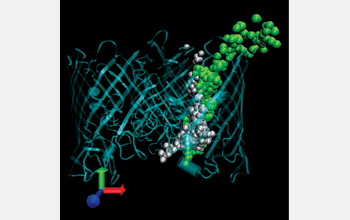Multimedia Gallery
Particle Simulation Results
Particle Simulation Results
This image shows particle simulation results for the trajectories of potassium (green) and chlorine (grey) ions, permeating successfully the ompF porin ion channel found in the membrane of e. coli bacteria.
Since this ion channel is very resilient and readily available, it is studied as a candidate for the realization of artificial, bio-inspired membranes for sensing devices. The simulator BioMOCA used to obtain these results was developed with National Science Foundation support through the Network for Computational Nanotechnology program.
The simulation was created by Umberto Ravaioli, a professor at the University of Illinois in the Department of Electrical and Computer Engineering, and the leader of the Multiscale Computational Nanosystems group at the Beckman Institute. Ravaioli's main research interests are in the area of transport simulation in nanostructures. His group has developed self-consistent 2-D and 3-D Monte Carlo simulators for nanoscale silicon devices, which have been applied to the study of ultra-scaled, conventional and double-gate MOSFETs and FinFETs. These simulation tools are being used by research groups at major semiconductor companies.
The same simulation methodologies have been applied recently to study transport of ions across ion channels in biological and bio-inspired membranes. (Date of Image: September 2006)
Credit: Gulzar Kathawala, Trudy van der Straaten and Umberto Ravaioli, University of Illinois
Images and other media in the National Science Foundation Multimedia Gallery are available for use in print and electronic material by NSF employees, members of the media, university staff, teachers and the general public. All media in the gallery are intended for personal, educational and nonprofit/non-commercial use only.
Images credited to the National Science Foundation, a federal agency, are in the public domain. The images were created by employees of the United States Government as part of their official duties or prepared by contractors as "works for hire" for NSF. You may freely use NSF-credited images and, at your discretion, credit NSF with a "Courtesy: National Science Foundation" notation.
Additional information about general usage can be found in Conditions.
Also Available:
Download the high-resolution JPG version of the image. (2.6 MB)
Use your mouse to right-click (Mac users may need to Ctrl-click) the link above and choose the option that will save the file or target to your computer.

